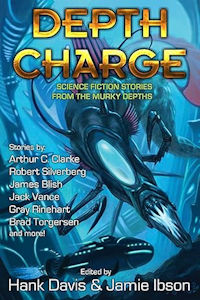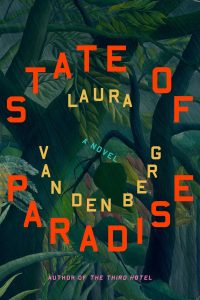Depth Charge, edited by Hank Davis & Jamie Ibson: Review by Paul Di Filippo
 Depth Charge, edited by Hank Davis & Jamie Ibson (Baen 978-1982193829, trade paperback, 288pp, $18.00) December 2024
Depth Charge, edited by Hank Davis & Jamie Ibson (Baen 978-1982193829, trade paperback, 288pp, $18.00) December 2024
Not so very long ago, the fantastika publishing ecology held open a niche for a species known as the “reprint anthology.” These creatures flourished under the expert hands of such caretakers as Damon Knight, Groff Conklin, Isaac Asimov, Richard Lupoff, Judith Merril and scores of other expert compilers. Their reason for living exemplified by these creatures was simple: to gather together, either on a thematic basis, or simply on the basis of quality, stories which had been published once, but which deserved a second (or third, or fourth…) go-round. These magnificent beasts served many noble purposes.
First, they constituted a small but pleasant secondary income stream for writers, as well as serving as a font of egoboo. Every little bit of cash and acclaim helps the struggling artiste.
Second, they helped to define the canon. The prevalence of reprints was a metric for value and centrality in the genre. For instance, visit the page for “The Cold Equations” at ISFDB, and witness about six screens worth of reprints as testimony to that tale’s vitality.
Third, they illustrated the history of the field along many vectors: sheer chronological progression of the art, or exfoliation of themes.
Last, but far from least, they alerted readers to new writers and undiscovered gems. Thanks to the wise curatorship of the editors, you could count on reading either the work of a fine writer unknown to you, or the work of a writer you knew, but whose particular tale you had not yet encountered. Such introductions served as a springboard to further reading by the audience. The editors did all that: a job still needed even in this era, when so much of SF’s backstock has been digitized, but finding a treasure is much harder than it looks.
One fellow in love with anthologies and able to limn their virtues with discernment was my friend Bud Webster, who alas died too young. However, his great non-fiction survey of anthologies, Anthopology 101, is still out there for your delight.
Nowadays, though, a good reprint anthology is a rare commodity, Mike Ashley produces many, either in conjunction with the British Library series of classics, or on his own. And then of course, we have all the best-of-the-year compilations. But they are a little hindered by having their scope reduced to twelve months out of the entire history of the field.
Thankfully, however, Hank Davis and his cronies at Baen Books are almost singlehandedly keeping this niche populated. Check out his page at ISFDB for his catalog—the latest of which is Depth Charges. The theme here is SF stories of oceans and seas, whether on Terra or other worlds, and he’s assembled a great table of contents. Acknowledging his keen-eyed Introduction, and the equally neat Afterword by his collaborator, Jamie Ibson, we move on to the fiction.
Farming, harvesting or remediating Earth’s oceans is a daily journalistic topic in 2024, and “The Deep Range” by Arthur C. Clarke remains as pertinent as ever, with its talk of a “World Food Administration” and its trained porpoises as partners to mankind. Clarke’s patented transparent prose hides a wry humor.
Our bioengineered future is just beginning in reality, but in “Selkies” by Mary Rosenblum, we encounter one of its logical extensions: a highly emotional and dramatic confrontation between humankind and its aquatic successors, tinged with a mother-daughter dynamic.
Entirely of its 1950s era, yet still packing a grand dystopian nihilistic punch, Robert Silverberg’s “The Four” employs psionics and atomic war to deliver a short sharp shock.
The good-old, yet eternally valid confrontation between hidebound elders and optimistic youth receives a thrilling outing in Brad Torgersen’s “Ray of Light.” Confined to sea-floor domes because the Earth’s surface is irreparably damaged, the adult rulers don’t reckon with the novelty-seeking instincts and dissatisfactions of their children.
Just about anything I can say regarding Jack Vance is gilding the lily. You can count on him for thrills, exotica and the dangerous exploits of principled individuals, and “The Gift of Gab” is no exception. Human are trying to morally exploit the resources of the alien water world Sabria, but an unscrupulous individual raises the ire of the native dekabrachs. Our hero can save the day—if only he can teach a race forever illiterate the powers of language. The Cthulhu-like look of the dekabrachs is, I think, a purposeful recasting of that alien god as a misunderstood individual.
Frederic Brown was known for his flash fictions with a sting, and that’s what we get in “Fish Story.” Man meets mermaid, falls in lust, and gets his unexpected “intimacy.”
James Blish’s “Surface Tension” stands in the top 100 of SF stories, I feel. In one sense, it is “merely” a tale of scale—humanity reduced to microscopic entities, a la Ray Cummings and his Golden Atom series. But in its depiction of a sense of wonder, humanity’s urge for new frontiers, the power of legends, and the persistence of the soul across all dimensions, it is unexcelled.
Fritz Leiber delivers “Later Than You Think”, one of those “aliens try to fathom an extinct humanity” tales, but with a great twist at the end. He blithely tosses off ideas such as this: “A cultural Second Law of Thermodynamics…the intellect and all its works are gradually degraded to the lowest level of meaning and creativity.”
“The Song of Uullioll” by Gray Rinehart (a writer I had never encountered; see how anthologies work!) immerses us in the nonhuman mind of an “adolescent” aquatic dweller, and proves that rebellion of juvenile spirit is universal.
James Cambias brings us “The Ocean of the Blind,” which charts with unrepentant black humor the sad but deserved fate of a media personality who seeks to outwit the “blind” underwater natives of Ilmatar.
And finally we get the oldest piece, a novella from the Forties by Henry Kuttner and C. L. Moore. As the SF Encyclopedia remind us: “the remarkable ‘Clash by Night’ [is]… a preliminary study in the Keeps sequence, which climaxes in Fury. Over and above its virtues as a Planetary Romance set on Venus, the sequence is notable for the clarity and power of its depiction of the Keeps which house humanity Under the Sea.” A tale of the tensions between military and civilian lifestyles, as well as a forerunner of the notion of futuristic war as a deadly gaming exercise, the tale might even be read as an allegory about World War II, in progress at the time. As you enjoy this adventure, try to remember that Fury itself was the favorite SF novel of William Burroughs!
This anthology not only provides plenty of bang for your reading buck, but also serves as an exemplar of what makes this kind of collection so powerful and necessary.
Interested in this title? Your purchase through the links below brings us a small amount of affiliate income and helps us keep doing all the reviews you love to read!
 While you are here, please take a moment to support Locus with a one-time or recurring donation. We rely on reader donations to keep the magazine and site going, and would like to keep the site paywall free, but WE NEED YOUR FINANCIAL SUPPORT to continue quality coverage of the science fiction and fantasy field.
While you are here, please take a moment to support Locus with a one-time or recurring donation. We rely on reader donations to keep the magazine and site going, and would like to keep the site paywall free, but WE NEED YOUR FINANCIAL SUPPORT to continue quality coverage of the science fiction and fantasy field.
©Locus Magazine. Copyrighted material may not be republished without permission of LSFF.








